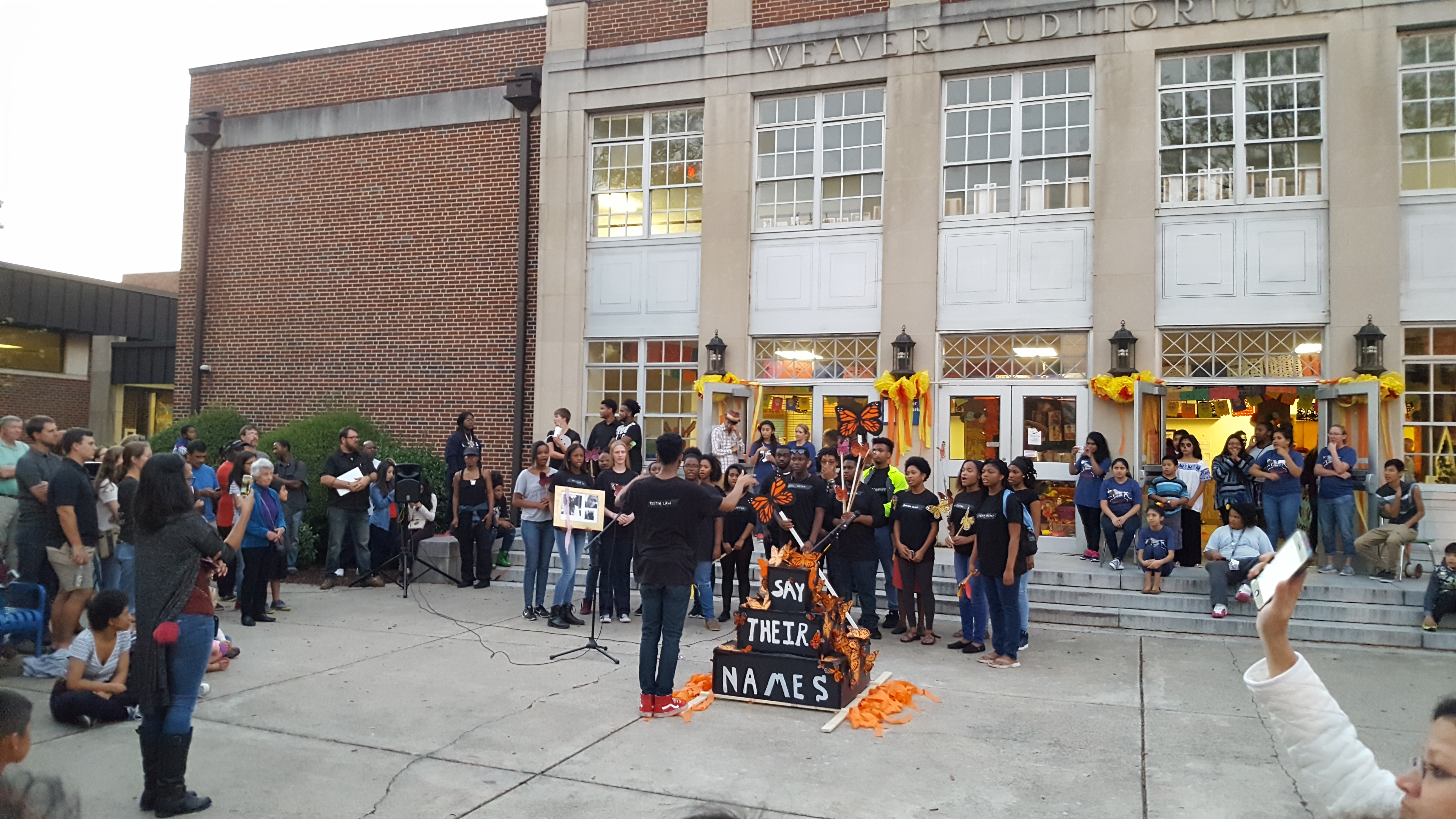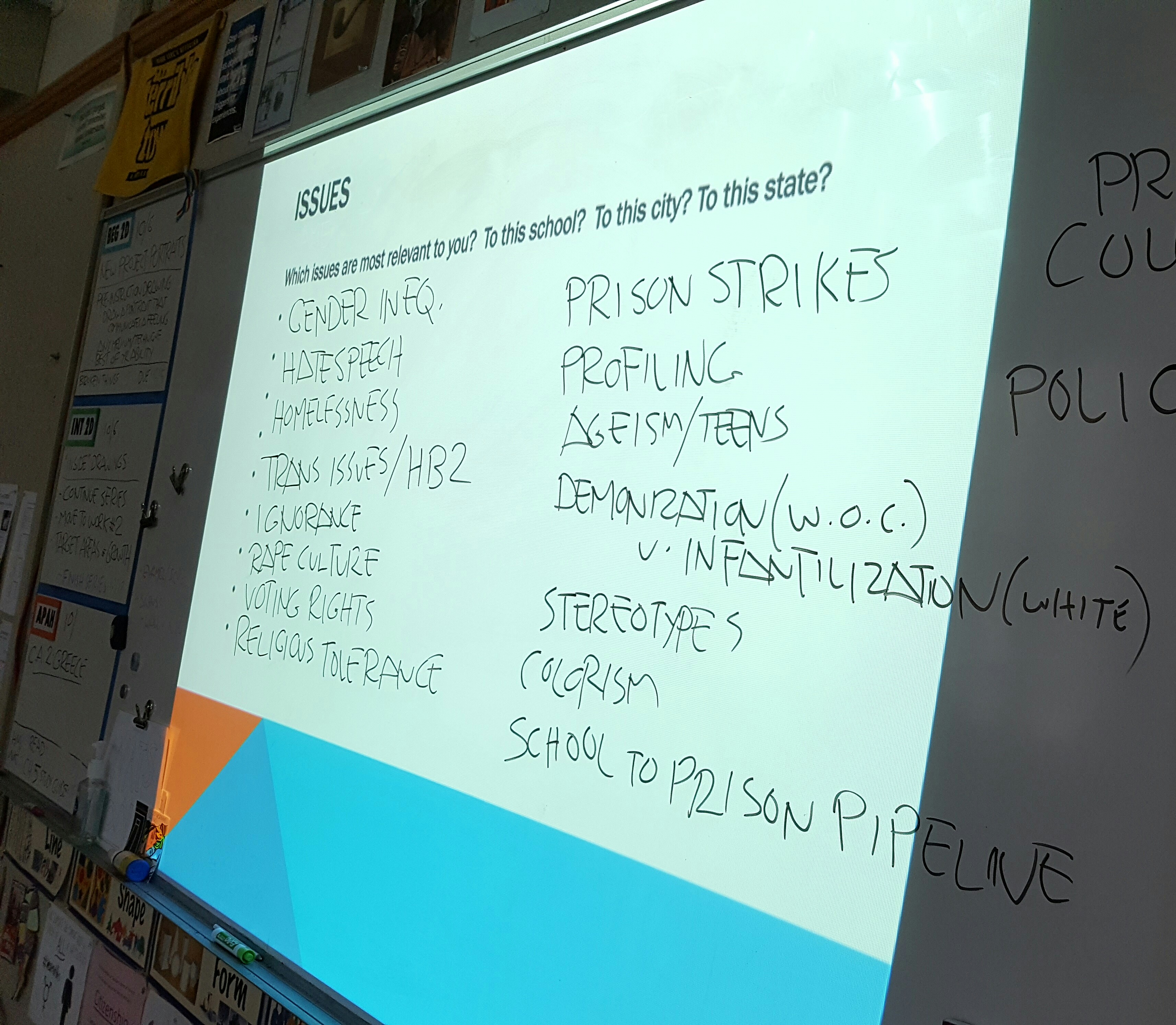
Members of Durham School of the Arts’ gospel choir perform with the Art + Action Say Their Names altar at the Fall Arts Festival, October 2016.
This creativity exercise is not a traditional lesson plan, but a response to a need for deeper engagement. I recently began teaching at a new school, the Durham School of the Arts, which is an art magnet school with a curriculum that favors technique and portfolio development but feels somewhat incomplete when it comes to social engagement and contemporary practices. How could I create a platform that would allow students to take agency over their own creative expression, while harnessing ideas that come from both process-based and social justice art-making traditions, outside the confines of a typical classroom project?
Inspired by the social activism of artists like Minerva Cuevas and Theaster Gates, I decided to start a new collective called Art + Action, which seeks to bring together groups of students from various social demographics and with different artistic backgrounds to work together at the intersection of art and activism. I see this collective as a way to bring diverse populations together, and also as a way to incorporate some twenty-first century artistic practices.
Art + Action is a student-directed collective of people—both artists and non-artists—who are interested in engaging with communities in the school and beyond around issues of social justice. With recent developments in North Carolina like the anti-transgender legislation HB2, and the uprising in Charlotte over police brutality, there is so much to respond to, and allowing students a meaningful way to contribute to the conversation is something that can help them grow into more engaged, socially-adept adults.
A student board runs the group, and they’re already busy creating committees around certain project ideas. As educator, my role is only to support and facilitate. We had our first meeting last month, and I was excited to see it attended by an enthusiastic group of kids. Twelve students signed up to be on the student board, and they brainstormed a list of issues they hope to address, including everything from profiling and ageism to the “demonization of women of color vs. infantilization of white women.” We are planning to join forces with the QSA (Queer Straight Alliance) and have already hit the ground running.
In the collective’s first month of existence, we were enlisted to create an altar for our school’s Día de los Muertos-themed fall arts festival. The student-designed theme of our altar was “Say Their Names,” to commemorate the lives lost to police violence. The altar became the subject of some controversy in our school, which culminated with a round-table discussion between the principal, some teachers, a local artist, and Art + Action members. A conversation like this had never happened before, and it is interventions like this where our collective becomes productive. Students and the principal eventually reached a compromise to more broadly include victims of racial injustice, which became an emotional end to the procession of altars when it became the backdrop for a performance by the school’s gospel choir.
When I posted about this new social justice collective on the Art21 Educators’ message board online, I was impressed—but not surprised—to learn that other educators in our community had undertaken similar projects. The question “how can art be a form of activism?” seems to open up the possibilities of what art can accomplish and why it matters for students.
So while this may not be a traditional creativity exercise or lesson plan, I encourage educators looking for ways to actively engage their students to create a platform that allows students to make art around issues that matter to them. A few organizations, artists and Art21 films I found helpful are:
- Theaster Gates and Pedro Reyes in Art in the Twenty-First Century Season 8
- Mark Bradford in Season 4
- Nick Cave in Season 8, and his Art21 Exclusive, “Thick Skin”
- Fred Wilson in Season 3
- Urban Bush Women, a nonprofit dance company in Brooklyn
- Concerned New Yorkers
- Center for Urban Pedagogy
- The Yes Men, an activist group creating satirical interventions
- Allora & Calzadilla in Season 4
- The Fallen Fruit collective in LA
- The Bruce High Quality Art Foundation
- Minerva Cuevas in Season 8
It’s impossible to not get inspired after hearing about the ways these artists and collectives are transforming their communities through their work. We’ll see where our Art + Action group takes us this year, but the kids are already brainstorming in ways that top-down teaching was never able to facilitate.




